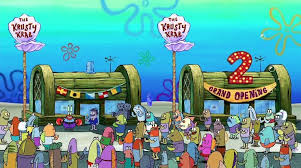Could Spongebob Teach You About Software Development?
I’m ready! I’m ready! I’m ready! - Spongebob SquarePants (and me, every Monday morning… after lots of coffee)
Okay, maybe not every Monday. There was this one time when I spent two hours trying to figure out why my Java application was throwing a NullPointerException. It turned out that I had forgotten to initialise a crucial object.
Facepalm.
It was a classic ‘Where’s the remote control’ moment - the solution was so obvious, it was almost invisible. Then it dawned on me: Spongebob Squarepants, the absorbing, yellow resident of Bikini Bottom, can teach us a lot about software development.
I know, it sounds crazy. But hear me out.
Despite the fact that Spongebob is a cartoon character who flips Krabby Patties for a living, he has some surprisingly relevant lessons for anyone working in tech. From navigating the sometimes turbulent waters of teamwork at the Krusty Krab to debugging mysterious code, Spongebob’s adventures offer valuable insights.
Lesson 1: The Importance of Teamwork
Let's face it, the Krusty Krab is not exactly the epitome of workplace harmony.
You have Spongebob, the optimistic cook; Squidward, the disgruntled cashier; and Mr Krabs, the... well, let's just say it his priorities don't always align with the well-being of his employees.
It's a recipe for chaos and yet they manage to make those Krabby Patties and keep the customers happy.

In the world of software development, teamwork is very important. For everyone actually, software development is rarely a one-man job. There are usually many issues that need to be discussed. Things that not everyone agrees on, which is why communication is also important.
Think of it this way: Spongebob’s infectious enthusiasm could be that junior developer who is always open to trying new things and brings a fresh perspective. Squidward’s cynicism, could be a valuable reality check that helps identify potential problems. And even Mr Krabs’ micromanaging tendencies (okay, maybe not all of them) highlight the importance of clear roles and responsibilities within a project. Someone needs to keep an eye on the ‘bottom line’ (if only to make sure the code really works).
The key lesson? A successful software development team, like the Krusty Krab crew, needs different personalities and skills. The key is to find a way to leverage everyone’s strengths and mitigate their weaknesses.
Lesson 2: Debugging Like a Goofy Goober
Software development is really just a series of increasingly complex debugging challenges. And who knows more about tackling seemingly impossible challenges than Spongebob Squarepants? Whether he is trying to perfect the Krabby Patty recipe, winning a jellyfish fishing contest or just surviving another day with Squidward, Spongebob is constantly faced with problems that require patience, perseverance and a healthy dose of creative problem-solving.
Think about it: debugging is a lot like looking for the lost spatula in the Krusty Crab. You know it’s somewhere, but to find it you have to search systematically, be willing to try different approaches and maybe even get a little lucky.
Spongebob’s willingness to try different approaches, even the silly ones, is a valuable lesson for any developer. Sometimes the solution to a bug is as unexpected as discovering that mayonnaise can be a tool. It’s about being open to new ideas, experimenting with different solutions and not being afraid to look a little silly.
And just as Spongebob breaks down Krabby Patty’s recipe into individual steps, we need to break down complex problems into smaller, more manageable pieces. Divide and conquer, as they say. Isolate the problem, examine the code and test your assumptions.
Next time you are stuck with a particularly frustrating problem, bring out your inner Spongebob. Take a deep breath, put on your Goofy Goober hat and remember that even the most impossible problems can be solved with a little patience and a whole lot of creative thinking.
Lesson 3: Embracing Change
The landscape of software development is constantly evolving. New technologies, frameworks and methodologies appear at a dizzying pace. It can feel like you are constantly playing catch-up to stay ahead of developments. But like Spongebob, we must learn to embrace change, even if it is… well, let’s just say it’s not always an improvement.
Consider the Krusty Krab. It is not a static burger joint. It is constantly being reinvented, sometimes for the better (like when they added the salad bar) and sometimes for the worse (like… the Krusty Krab 2). Remember that episode? Giant slides, a confusing menu and a general sense of soullessness.
It was a disaster!
But even with such a radical (and questionable) transformation, Spongebob manages to adapt and thrive.
He may miss the old Krusty Krab, but he is still willing to give the new one a chance.
He is open to learning new skills, mastering new techniques and finding new ways to flip those Krabby Patties.

That is the key to success in software development: adaptability. We have to be willing to explore new frameworks and embrace new methodologies. We have to be open to new ideas, even if they seem strange or unfamiliar at first.
So the next time you are faced with a new technology or have to revise a big project, think of Spongebob and the Krusty Krab 2. Embrace the change, be willing to learn and remember that even if it seems like a disaster at first, you can always find a way to adapt and evolve. And if all else fails, you can always go back to the old Krusty Krab.
Lesson 4: The Dangers of Procrastination
We’ve all been there: staring at a blank screen, knowing a deadline is looming, but somehow finding a million other things to do instead. It’s the siren song of procrastination, and even SpongeBob SquarePants isn’t immune to its allure.
Remember that episode where SpongeBob has to deliver a Krusty Krab pizza? It seems like a simple task, but SpongeBob manages to turn it into an epic journey filled with obstacles, delays, and a ton of unnecessary stress. Why? Because he procrastinates! He gets distracted, takes a detour, and leaves the delivery until the very last minute.
In the world of software development, procrastination can be just as disastrous. Putting off tasks, delaying code reviews, and ignoring deadlines can lead to missed milestones, defective code, and a ton of unnecessary stress for the entire team.
Spongebob’s last-minute struggle to deliver the pizza is a perfect example of what not to do. With better planning, time management, and a little less craziness, he could have avoided the whole ordeal.
That’s why it’s so important to use project management tools and techniques to stay on track. Tools like Jira, Trello, and many more can help you break down tasks, set deadlines, and track your progress. Techniques like the Pomodoro Technique and time blocking can help you stay focused and avoid distractions.
So, the next time you’re tempted to procrastinate, think of Spongebob and the Krusty Krab Pizza. Don’t let procrastination turn your project into an epic journey of unnecessary stress. Stay focused, manage your time effectively, and deliver the code on time!
Lesson 5: The Value of Documentation
The Krabby Patty Formula.
It’s the best-kept secret in Bikini Bottom and the foundation of Mr. Krabs’ entire business empire. But while the formula itself is shrouded in mystery, the process of creating a Krabby Patty is (I assume) well-documented. After all, SpongeBob manages to produce them day in and day out, with consistent quality.
In the world of software development, documentation is just as crucial as the Krabby Patty Formula. It’s the key to understanding how your code works, how to use it effectively, and how to maintain it over time.
Think about it: What happens when you inherit a project with little or no documentation? It’s like trying to decipher Mr. Krabs’ gibberish about the Krabby Patty Formula—you might get a general idea of what’s going on, but you’ll probably end up confused, frustrated, and ultimately wasting a lot of time.
Clear and concise documentation can prevent all of that. It can help new team members get up to speed quickly, reduce the risk of bugs, and make your code easier to maintain and update.
 So the next time you’re tempted to skip the documentation, remember the Krabby Patty formula.
Don’t let your code become a mysterious secret that only you can understand.
Document your code clearly and concisely, and you’ll be doing yourself (and your team) a big favor in the long run.
So the next time you’re tempted to skip the documentation, remember the Krabby Patty formula.
Don’t let your code become a mysterious secret that only you can understand.
Document your code clearly and concisely, and you’ll be doing yourself (and your team) a big favor in the long run.
Conclusion
So, what did we learn from Spongebob Squarepants? Surprisingly, a lot! From the importance of teamwork and communication to the need for patience and creative problem solving, Spongebob’s adventures in Bikini Bottom offer valuable insights for software developers of all levels.
We’ve seen how Spongebob’s enthusiasm can be infectious, how Squidward’s cynicism can be a valuable reality check, and how even Mr. Krabs’s tendency to micromanage can underscore the importance of clear roles and responsibilities. We’ve learned that debugging is like finding a lost spatula, that embracing change is like surviving Krusty Krab 2, that procrastination is like forgetting to deliver pizza, and that documentation is as crucial as the Krabby Patty formula.
These lessons aren’t just for cartoon characters. They’re essential to success in the real world of software development. By embracing these principles, we can write better code, work more effectively as a team, and ultimately create better software.
So the next time you’re faced with a challenging project, a frustrating bug, or a difficult team member, think of Spongebob Squarepants.
Take a deep breath, and ask yourself, “What would Spongebob do?”
